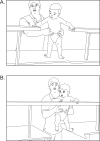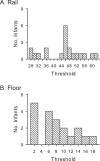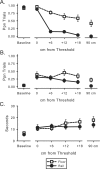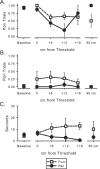Developmental continuity? Crawling, cruising, and walking
- PMID: 21399716
- PMCID: PMC3050596
- DOI: 10.1111/j.1467-7687.2010.00981.x
Developmental continuity? Crawling, cruising, and walking
Abstract
This research examined developmental continuity between "cruising" (moving sideways holding onto furniture for support) and walking. Because cruising and walking involve locomotion in an upright posture, researchers have assumed that cruising is functionally related to walking. Study 1 showed that most infants crawl and cruise concurrently prior to walking, amassing several weeks of experience with both skills. Study 2 showed that cruising infants perceive affordances for locomotion over an adjustable gap in a handrail used for manual support, but despite weeks of cruising experience, cruisers are largely oblivious to the dangers of gaps in the floor beneath their feet. Study 3 replicated the floor-gap findings for infants taking their first independent walking steps, and showed that new walkers also misperceive affordances for locomoting between gaps in a handrail. The findings suggest that weeks of cruising do not teach infants a basic fact about walking: the necessity of a floor to support their body. Moreover, this research demonstrated that developmental milestones that are temporally contiguous and structurally similar might have important functional discontinuities.
Keywords: crawling; cruising; developmental continuity; locomotion; walking.
Figures




References
-
- Adolph KE. Psychophysical assessment of toddlers' ability to cope with slopes. Journal of Experimental Psychology: Human Perception and Performance. 1995;21:734–750. - PubMed
-
- Adolph KE. Learning in the development of infant locomotion. Monographs of the Society for Research in Child Development. 1997;62(3, Serial No. 251) - PubMed
-
- Adolph KE. Specificity of learning: Why infants fall over a veritable cliff. Psychological Science. 2000;11:290–295. - PubMed
-
- Adolph KE, Berger SE. Motor development. In: Kuhn D, Siegler RS, editors. Handbook of child psychology: Vol. 2. Cognition, perception, and language. 6th ed. John Wiley & Sons; New York: 2006. pp. 161–213.
Publication types
MeSH terms
Grants and funding
LinkOut - more resources
Full Text Sources
Medical
Miscellaneous

